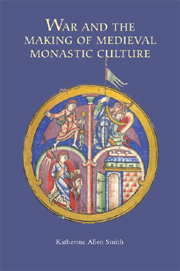Book contents
- Frontmatter
- Contents
- Dedication
- Acknowledgments
- List of Abbreviations
- Introduction
- 1 Encountering War in the Scriptures and Liturgy
- 2 Monks and Warriors: Negotiating Boundaries
- 3 Spiritual Warfare: The History of an Idea to c.1200
- 4 Martial Imagery in Monastic Texts
- 5 Warriors as Spiritual Exemplars
- Conclusion
- Appendix: The Loricati, c.1050–1250
- Bibliography
- Index
- Title in the Series
2 - Monks and Warriors: Negotiating Boundaries
Published online by Cambridge University Press: 05 February 2013
- Frontmatter
- Contents
- Dedication
- Acknowledgments
- List of Abbreviations
- Introduction
- 1 Encountering War in the Scriptures and Liturgy
- 2 Monks and Warriors: Negotiating Boundaries
- 3 Spiritual Warfare: The History of an Idea to c.1200
- 4 Martial Imagery in Monastic Texts
- 5 Warriors as Spiritual Exemplars
- Conclusion
- Appendix: The Loricati, c.1050–1250
- Bibliography
- Index
- Title in the Series
Summary
‘It is good for a man to know his established order,’ wrote the twelfth-century canon Philip of Harvengt, ‘and its limit or boundary, lest he impudently presume to go beyond its fixed boundaries, or weakly shrink from them.’ Philip's sentiment reflects the deeply felt concern with the definition of orders (ordines) and the reinforcement of boundaries between them that runs through much of the writing of eleventh- and twelfth-century churchmen. This interest did not consistently reflect a real or imagined tripartite system of ‘those who prayed, fought, and worked’; throughout this period, various schema were current which divided society into anywhere from two to seven groups according to a variety of criteria including vocation, birth, gender, religion, and marital status. nevertheless, one division all theorists recognized as fundamental was that between the clergy and laity, who were distinguished by their respective spiritual statures, social functions, and legal jurisdictions. Many writers further insisted on the existence of a monastic ordo, usually judged to be superior to the secular clergy, from whom monks and nuns were distinguished by their enclosure, poverty, stability, dress, and diet. In reality, of course, there was no monolithic monastic ‘order’ in the central Middle ages, a period which saw the proliferation of new religious orders as well as the emergence of hybrid groups within the church whose exact status remained unclear. neither members of the monastic ordo in the traditional sense, nor truly part of the laity, members of the military orders, lay brothers and sisters, and wandering hermits all defied categorization, to the consternation of clerical theorists.
- Type
- Chapter
- Information
- War and the Making of Medieval Monastic Culture , pp. 39 - 70Publisher: Boydell & BrewerPrint publication year: 2011



